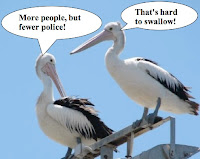 |
| Kurrawong |
The large, charcoal-grey Kurrawongs have bright yellow eyes and flashes of white on their tail and wings. Allegedly, their name comes from their musical call, but you need some imagination to hear it! It's been several months since they've been in the area, because Kurrawongs are migratory, moving between feeding and breeding grounds.
The reappearance of the Kurrawongs in the area coincides with a visit by a group of Kookaburras. Interesting birds, Kookaburras are notable for their socialised child care! Kookaburras live in groups and in each group, one or two adults will look after young birds from several pairs of adults - an efficient, cost-effective approach to child care of which, no doubt, federal treasurers would approve! Kookaburras are migratory, too, but a group will generally move around a regular route.
 |
| Kookaburra |
A 'wildlife corridor' - who needs it?
The recurring presence of the Kurrawongs and Kookaburras in the area shows the importance of the 'nature corridor' formed by the stretch of trees and shrubs along Griggs Creek that crosses Jetty Road and continues to McLeod's Waterholes. Many other birds, including Galahs, Lorikeets and Red-rumped Parrots (a.k.a. Grass Parrots) also fly regularly along that corridor; and Wattle Birds and Honeyeaters are semi-permanent residents.
Until recently, the corridor had a 'spur' of some trees at the junction of Jetty Road and Wyndham Street, but these were destroyed to make way for the enlarged junction. These trees formed a local landmark, but the first that local people knew of the trees' fate was when they awoke to the sound of chain saws cutting them down. Among the trees was an old Willow tree, described by the contractor's supervisor as 'just a weed'!
Doing what's legal - or doing what's right?
When the City of Greater Geelong's supervising engineer was asked why the council hadn't consulted local people about the trees' planned destruction, he replied, 'We don't have to'. He meant that the council has a legal obligation to consult the public about changes to bylaws, etc (e.g. re-zoning), but has no legal obligation to consult the public about any 'non-legal' issues - and destroying these trees was one of those 'non-legal' issues.
So the council's guiding principle isn't 'What is right?' but 'What can we get away with?' A council's operations offer many opportunities to strengthen local democracy and build citizenship by involving local people in council decisions that affect them. For this council, however, local democracy appears to mean 'electing a councillor every four years'; and citizenship appears to mean 'paying your rates on time'.























